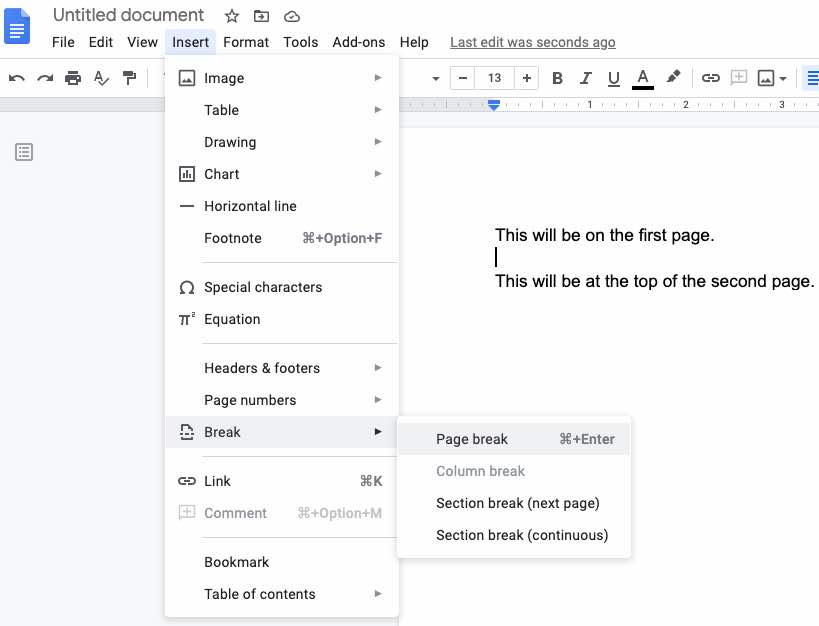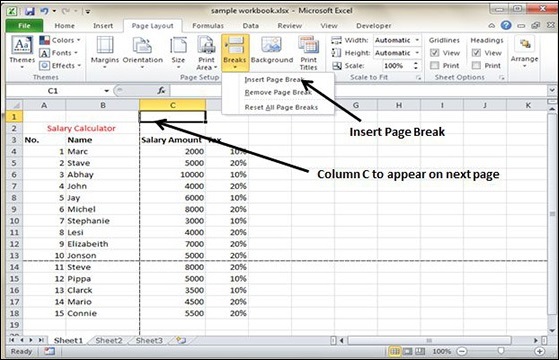
Tutorials Point is a leading Ed Tech company striving to provide the best learning material on technical and non-technical subjects. is a dedicated website to provide quality online education in the domains of Computer Science, Information Technology, Programming Languages, and other Engineering as well as Management subjects. It cannot be applied on empty, etc., elements which don’t create a box. Note − This property is only applicable for block elements which creates a box within it. For example, avoiding page breaks within an image element. Page-break-inside − It is used to add or sometimes avoid page breaks inside an HTML element. For example, adding page break before the header element. Put your cursor where you want one page to end and the next to begin. When starting with an empty document, you should observe the following change on your screen: Notice the change of the size of the cursor. Alternatively, you may type \section followed by return. Page-break-before − It is used to add page breaks before a specified HTML element. In order to start a new section, you should press ->Section or Text->Section. Right-click on it and pick Insert Page Break. 3 Select the column to the right of your desired vertical line break.
#Inseert page break texmacs manual#
From the options, select 'Insert Page Break.' A thick line will appear where the manual break was inserted. If you need to insert a vertical page break, pick the necessary column to the right. Return to the 'Page Layout' tab and click the arrow beneath the 'Breaks' icon. Right-click on this row and select the Insert Page Break option from the menu list. To add a horizontal page break, select the row where the marking line will appear. For example, adding page break after the footer element. Now you can easily view the location of page breaks in your worksheet. Page-break-after − It is used to add page breaks after an HTML element. Keeps track of the position of the tree inside the global document tree and can be used to programmatically modify documents. Active trees (tree).TeXmacs internal C++ type tree which is exported to Scheme via the glue.

Usually there are three types of page breaks. convenient to manipulate content directly using standard Scheme routines on lists. While designing a web page, we use the page-break property of CSS to show the same before, after or inside the elements. In simple words, page break means a dotted line or a pattern which separates two consecutive web pages. Let’s see about what actually is a page break. Generally, it is used to define how a document should behave after being printed. Next, go to the Page Layout menu and select Insert Page Break. We selected the A9 cell and applied the breaks in this example. It is a good practice to add a page-break after every footer so as to make the users easy to understand and read our website. Select any cell in column A or right below the row where we want to insert the page break. In this article, we will see one more extensive use of a CSS property named as page-break. It makes our web page more attractive and user-friendly. The page break is inserted and the document pagination is adjusted to accommodate it.CSS (Cascading Style Sheets) is a stylesheet language which enables the developers to style and format the HTML or XML elements in a web page. If the current page is odd, the content continues on the current page with no visible page break.

If the current page is even, the content continues on the current page with no visible page break.Ĭontinues content on the next odd numbered page. If the next page is not odd, a blank page is automatically inserted to force the content to an odd numbered page.Ĭontinues content on the next even numbered page. If the next page is not even, a blank page is automatically inserted to force the content to an even numbered page.Ĭontinues content on the next odd numbered page.

OptionĬontinues content on the next even numbered page. addParagraph.RTF: Insert a paragraph into the RTF document addPlot.RTF: Insert a plot into the RTF document addPng.RTF: Insert an existing PNG image into the. In the Page Break dialog, select the type of page break to insert. addHeader.RTF: Insert a header into the RTF document addNewLine.RTF: Insert a new line into the RTF document addPageBreak.RTF: Insert a page break into the RTF document optionally.


 0 kommentar(er)
0 kommentar(er)
